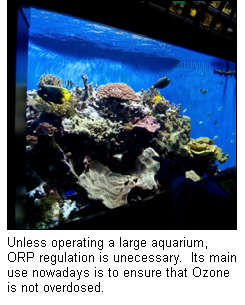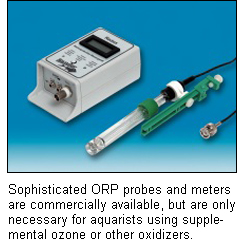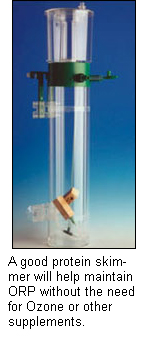Chemistry Corner, Your Guide to: ORP


Opening
Chemistry Corner often provides an avenue to expand on subject matter that is regularly glossed over. In some cases, however, the exact opposite is true. The next subject of this periodical is Oxidation-Reduction Potential, or ORP, and it is a deep and poorly-understood one. ORP, in very broad terms, is a measure of electrical conductivity that can be related to an aquariums ability to recycle organic material. More specifically, ORP meters sense the voltage potential created by charged particles in the water column. Research into the matter uncovered lengthy discussions regarding the complex web of factors that may, or may not, influence ORP levels in seawater. The story is rife with unknown or unmeasured chemical reactions that muddle attempts to paint an overview. That ORP is important is implicit, but the real question is whether it is something you should even try to control. In fact, it might not even need measuring. It is clear, then, that the job of this edition of Chemistry Corner is to provide a digestible version of this tricky tale.
Redox
The story starts with the cast members, who can be divided into two categories. There are Oxidizers and Reducers, and when they meet an Oxidation-Reduction (Redox) reaction occurs. Understanding the role of oxidizers and reducers can be confusing because oxidizers actually get reduced, and vice-versa. Really, it is all about the transfer of electrons, which carry an electrical charge of negative one. When an ion or a molecule approaches another with lesser affinity for electrons, electrons can jump ship to the geater of the two. This transfer of electrons is the process of ionization, and results in each participating ion changing overall charge. Oxidizers are reduced because they strip electrons from reducers, thereby gaining more negative charge. Consequently, the charge of the oxidizer is reduced. Conversely, when the reducer loses its electron, it loses a negative charge and becomes oxidized. Ionization is incredibly important in general chemistry, and not surprisingly, is very important in biology as well. In seawater, redox reactions usually occur between organic reducers and inorganic oxidizers.

ORP, in Short
ORP is used to measure a solutions electrical potential at an electrode. In other words, atoms bombard the electrode, either trying to give it electrons or else take electrons away. The resulting flow of electrons generates an electrical current across a cell (usually measured in milliVoltsmV). The magnitude and direction of the current are measured and reported as ORP; the higher the concentration of oxidizers in the solution, the higher the ORP value. In some senses, the ORP is an estimate of an aquarium systems ability to recycle organic materials in the form of food, dead tissue, and excrement. Though it was once thought to be a measure of the waters cleanliness or purity, ORP is now understood to give us only a broad estimate of the stability of the smorgasbord of constituents in seawater.
At first glance, ORP seems reasonably simple to understand, but it is neither easy to understand, nor easy to interpret measurements. The principle goal of an ORP measurement is to put a numerical value on the sum contributions of all the oxidizers and all the reducers in a solution, and compare the values against a known potential. The problem is that the process assumes that all these constituents are at equilibrium, when in fact they are not. We know this because products and reactants can be measured in the same solution, concentrations ever-present but constantly varying. The varying concentrations are due, in part, to numerous disparate influences. UV light can change some molecules into redox reactants, while biological processes and dissolved gases also provide contributors. As that were not enough, ORP is expected to fluctuate diurnally in a fashion similar to that of pH. Confusing the issue is the fact that changes in pH can impact ORP, but only if the acids and bases involved are also acting redox participants. Moreover, the probe itself maybe limited to interacting with particular ions, and not others. It can also get fouled up with mineral accretions, bacteria, and algaeall of which will influence ORP readings.

Monitoring ORP with a Meter
If you wish to use an ORP meter accurately, it is important to keep it calibrated and cleaned. You will also need to take a long-term approach, because while some redox reactions occur rapidly, others can literally take thousands of years to complete themselves. Such a vast difference in reactionary timescales is one reason it is so difficult to extract a true Redox Potential from an ORP meters report. Naturally, you are not going to wait a thousand years for your ORP meter to equilibrate, but the point is clear that reviewing the ORP over extended time periods is more helpful for understanding its role in your aquarium. Because it is difficult to accurately assess for ORP, the best you can hope for is that your meter is giving you inaccurate but precise data. That is, it is fine if your meter gives a somewhat different value than the real one, so long as it is always off by a consistent amount. Measuring ORP is all about tracking changes over time and establishing awareness of the way it cycles normally. That way both sudden and gradual changes can be noted. In short, it is not the absolute value of ORP that matters (unless it is very high or very low). Instead, it is the relative changes in ORP over time that tell you the most about the water in your system.
Over short timescales, ORP is really most useful as a way of predicting large changes in water chemistry. For example, consider the aquarist with a big tank. The tank has many dark recesses, and a lot of livestock that need accounting. If a fish were to die in an easily over-looked location, it may lie undiscovered, only to be hinted at by a sudden outbreak of cyanobacteria or nuisance algae. Within hours of the fish dying, however, an aquarist with a meter would begin to see a sharp depression in ORP. The sudden influx of large organic molecules changes the balance between oxidizers and reducers, and the milliVolts begin to drop. Fortunately, this forewarning allows the aquarist to seek out and remove the offending carcass, thereby preventing a catastrophic water quality breakdown.
The other important use of an ORP meter is in conjunction with the supplementation of oxidizing compounds. This used to be achieved with dosings of hydrogen peroxide or potassium permanganate. More recently, ozone has been used to raise ORP in large systems. Ozone is a powerful oxidizer, and forms a toxic gas at room temperature. It can kill aquarium livestock (and you!), so extreme caution should be exercised when using ozone. Whenever dosing any chemical designed to raise ORP, an ORP meter is absolutely essential. Raising ORP too much can result in the quick death of all your livestock, and even the bacterial biofilter as well. In the ocean, ORP has an astounding potential rangefrom 384 mV to 450 mV. That is a differential of 834 milliVolts, though the majority of ocean waters show ORP readings of between 300 and 450 mV. Aquaria are generally recommended to maintained from 200 to 450 mV, but these values arise more from demonstrated success than empirical evidence. That is to say, the ideal value is not scientifically derived. Rather, it comes from trial and error. As such, there is no singularly correct value for ORP; plus every aquarium operates uniquely anyhow, further eliminating the possibility for consensus.
Fortunately, most aquarists have no need for ORP meters, or supplemental oxidizers. The main reason is oxygen. Oxygen is a small diatomic molecule that is not as strongly oxidative as ozone and others. However, oxygen accounts for about 27% of the gas in the air at sea level. Suffice to say, there are a lot of oxygen molecules available to affect ORP. Well-oxygenated aquarium water should maintain optimal ORP levels without the need for regulation. Fortunately, most marine aquarists are now using one of the finest tools available for ORP regulationthe protein skimmer. The skimmer increases the surface area of the water so much that oxygen rapidly dissolves into solution. ORP, in turn, is elevated via the enhanced oxygen concentration. In fact, if you were to stick a probe into the reaction chamber of a protein skimmer, you would find that ORP was significantly higher within than without. For most home aquaria, ORP is sufficiently regulated by protein skimming and gas exchange at the water/air interface.

Wrap-up
As previously alluded to, there once was the belief that ORP measured the cleanliness of the tanks water. As we now know, the picture is decidedly less clear. It is tantamount to the chicken-and-the-egg question. Is ORP high because the tank is clean, or is the tank clean because the ORP is high? Or, in another distinct possibility, is the water clean and ORP high because of a third factor of an unknown nature? In most cases, there is no need to further explore the nature of ORP, and you will not need a meter. If a tank is adequately set up, equipped with an efficient protein skimmer, and possessing of good water flow, ORP should regulate itself. But make no bones about itif you want to mess with ORP, you have to get the meter.
Works Cited:
Brightwell, C.R. Marine Chemistry; a Complete Guide to Water Chemistry in Marine Aquariums. TFH Publications: Neptune City. 2007.
Edelman, E. Redox and ORP. Reefs Online. 1997. URL: < http://www.reefs.org/library/talklog/e_edelman_080397.html >
Farley, R.H. ORP and the Reef Aquarium. Reefkeeping Online Magazine. Dec. 2003. URL: < http://reefkeeping.com/issues/2003-12/rhf/feature/index.php >
Farley, R.H. Ozone and the Reef Aquarium, Part 1: Chemistry and Biochemistry. Reefkeeping Online Magazine. June 2003. URL: < http://reefkeeping.com/issues/2006-03/rhf/index.php >
Silberberg, M.S. Chemistry; the Molecular Nature of Matter and Change, 3rd Edition. McGraw Hill: Boston. 2003.